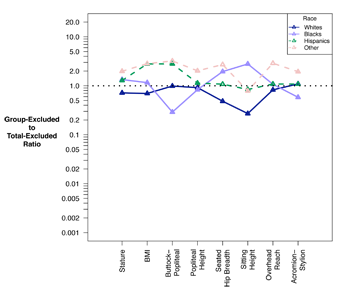When designing a product to interact with the human body, designers consider the sizes and shapes of people. A population’s variability in body size and shape can be accounted for in many ways, such as offering products in multiple sizes or including adjustability in products. Typically, it is not feasible to design a product to fit every single person in the population, so designers choose to design for a portion of the population. The remainder of the population is disaccommodated by the product. The people who are the biggest and the smallest by the product’s key limiting dimension are the most likely to be disaccommodated. This thesis seeks to find racial and gender-based trends in body dimensions that cause a disproportionate amount of a particular racial-specific or gender-and-racial-specific group to be disaccommodated. Distributions of anthropometric measurements for the general U.S. population and the U.S. military population are analyzed to determine what racial groups and what gender- and racial-specific groups are the most likely to be at the extremes of the distribution. A case study is included to show how these trends affect the racial makeup of the individuals who are disaccommodated by a chair.

